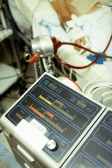The Bio-Pump® was originally developed for cardiopulmonary bypass, but it can be used for short periods (usually 5 or fewer days) of circulatory support beyond the surgical setting. The Bio-Pump has been used both in postcardiotomy cardiogenic shock patients (those who have developed heart failure as a result of heart surgery) and as a bridge to transplantation for patients who cannot be weaned from the device. This short-term assist device can be implanted in a broad range of patients, from newborns to adults, and can be used alone or along with another Bio-Pump or another type of assist device if biventricular support is needed.
The Pump
 The Bio-Pump is an extracorporeal, centrifugal device that can provide support for one or both ventricles. Two disposable models are available: the 80-mL model for adults and a 48-mL model for children. The transparent pump housing is shaped like a cone. The pump consists of an acrylic pump head with inlet and outlet ports placed at right angles to each other. The impeller, which is a stack of parallel cones, is driven by an external motor and power console. Rotation of this impeller at high speeds creates a vortex, which drives blood flow in relation to rotational speed. Blood enters through an inlet at the top of the cone and exits via an outlet at the base. The adult model pump can rotate up to 5000 rpm and can provide flow rates of up to 10 liters per minute.
The Bio-Pump is an extracorporeal, centrifugal device that can provide support for one or both ventricles. Two disposable models are available: the 80-mL model for adults and a 48-mL model for children. The transparent pump housing is shaped like a cone. The pump consists of an acrylic pump head with inlet and outlet ports placed at right angles to each other. The impeller, which is a stack of parallel cones, is driven by an external motor and power console. Rotation of this impeller at high speeds creates a vortex, which drives blood flow in relation to rotational speed. Blood enters through an inlet at the top of the cone and exits via an outlet at the base. The adult model pump can rotate up to 5000 rpm and can provide flow rates of up to 10 liters per minute.
 The Console
The Console
The Bio-Pump console is relatively small and easy to operate, although it does require continuous supervision by specially trained personnel. When fully charged, the system has an internal battery life of 45 minutes. A battery indicator light displays the charge level. A flow probe inserted in the patient's artery allows for a continuous readout of the blood flow rate. The operator can program the console for use in children or adults by selecting a high or low flow rate. The console features a numeric readout and a bar graph that shows flow rate and revolutions per minute.
For more information, you can read an article entitled, "Clinical Experience with BioMedicus Centrifugal Ventricular Support in 172 Patients," which appears in Volume 19 (1995) of the journal Artificial Organs (pp. 756-760).



